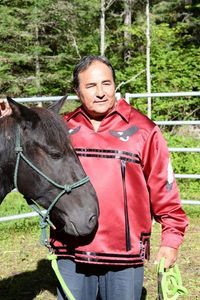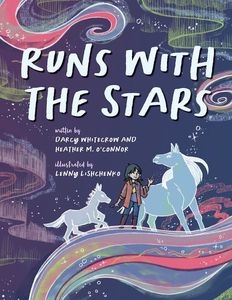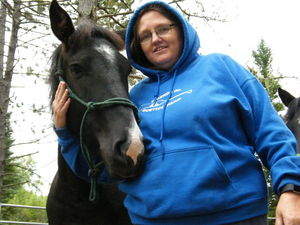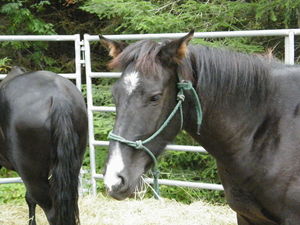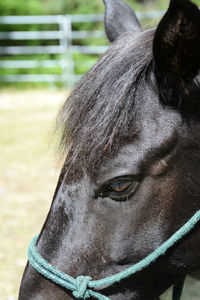Darcy Whitecrow & Heather M. O’Connor on Partnering to Tell a Story About the Unique & Endangered Ojibwe Horse Breed
The Ojibwe Horse was a unique type of wild horse, bred and cherished by the people they are named for. For centuries, Ojibwe people husbanded the horses, living and working together with them, until numbers dipped critically low in the late 1970s with urbanization and settler presence; eventually, just four mares remained. Crossbreeding saved the bloodline but the breed remains endangered to this day, with their Ojibwe defenders as the only reason they haven't disappeared altogether.
This story of preservation, perseverance, and history is captured powerfully for young readers in Darcy Whitecrow and Heather M. O’Connor's Runs with the Stars (Second Story Press, illustrated by Lenny Lishchenko). Unspooling in a conversation between a man and his grandchild as they await the birth of a precious new foal, the story of the beautiful, wild, forest-dwelling horses and the people who love them is sad and beautiful, with a hopeful note at its close: the grandfather has his own small, treasured herd of the horses, of which he takes loving care.
In Whitecrow and O'Connor's book, the grandfather is passing down not only his knowledge but his love for the horses, to introduce the child to the magic and responsibility of a bond between human and animal. Moving, meditative, and a great way to talk to children about the natural world, Runs with the Stars is a powerful addition to the picture book landscape.
We're happy to welcome both Darcy and Heather here today to talk about how and why the book was created. They tell us about how preserving the story of these special horses became important to them both, how Second Story has also published an Ojibwe language version of the book, Wiijibibamatoon-Anangoonan, and they even share photos of Darcy's own herd.
Open Book:
Tell us about your new book and how it came to be.
Heather M. O'Connor:
Wiijibamatoon-Anangoonan (Runs with the Stars) is the history of the Ojibwe Horse, wrapped up in the story of a young Ojibwe girl, waiting for her favourite horse Star to have her first foal.
I first heard about this rare breed a few years ago, on an assignment from Ontario Parks. But Darcy has known about them all his life. His people once lived and worked with these amazing wild horses, and his grandfather had horses.
Now, Darcy is preserving a herd of his own. When he told me how the Ojibwe Horse almost disappeared, I knew we had to preserve the breed’s story, too.
OB:
Is there a message you hope kids might take away from reading your book?
Darcy Whitecrow:
It is easy to stop connecting with nature in this age of technology. I am hoping that kids make that connection with nature and the horses. That’s so important in today’s society.
Your CanLit News
Subscribe to Open Book’s newsletter to get local book events, literary content, writing tips, and more in your inbox
At Grey Raven Ranch in Seine River First Nation, we use the horses to help kids reconnect with their traditional heritage. These horses are their legacy.
OB:
Did the book look the same in the end as your originally envisioned it when you started working, or did it change through the writing process?
Heather M. O'Connor:
Ha! I didn’t intend to tell this story at all!
I’d originally envisioned writing a middle grade or YA novel set on a horse ranch, not the untold history of this remarkable little horse. But I couldn’t get Darcy’s voice out of my head – especially the line “they used to run in the woods like the deer.”
So many people had never heard of the Ojibwe Horse, and it’s difficult to protect a breed no one knows about. So, I asked Darcy if he’d like to collaborate on a picture book to raise awareness. He said, “Sure!”
In doing so, we shone a light on an important, but little-known piece of Ojibwe history. And best of all, the story can be used in traditional language programs, because Second Story published an Ojibwe and English edition (Wiijibibamatoon-Anangoonan.)
I may get back to that novel someday, but I am so proud of what we’ve done.
OB:
Is there a character in your book that you relate to? If so, in what ways are you similar to your character and in what ways are you different?
Darcy Whitecrow:
I relate to the warm relationship between the grandchild and grandparent. It reflects my own relationship with my grandfather.
I cared about my grandfather so much. He loved and respected horses and nature. He was always ready to teach me whenever I was in his presence, and always passing down his knowledge for me carry it on.
OB:
What was the strangest or most memorable moment or experience during the writing process for you?
Heather M. O'Connor:
It would have to be meeting the horses for the first time.
Darcy and his partner Kimberlee Campbell take their horses to Quetico Provincial Park for a big special event every year. But Quetico is 1700 kilometres from where I live. It’s so far away it’s in a different time zone.
So I applied for an Access Copyright Marion Hebb Research Grant and flew up to meet the horses face to face and nose to nose. I loved their curious, friendly personalities, their furry, fuzzy ears, and their fascinating history.
Darcy and Kim and I hit it off right away, too. As they say in Casablanca, it was the beginning of a beautiful friendship.
OB:
What do you need in order to write – in terms of space, food, rituals, writing instruments?
Heather M. O'Connor:
I’m at my most productive writing in nature. I have a gazebo for the summertime, and I’m about to build a bunkie in my backyard. The peace and quiet allows ideas to tiptoe in.
But my best work has come when I’m away on retreat. Rustic lakefront writer’s residencies at Quetico, where even the trees whisper. An off-grid island retreat on Halls Island in Haliburton. A solitary month on retreat at Trickledown House, a beautiful century home in Gravenhurst, just five minutes from Lake Muskoka. Weekends at my dear friend’s cottage, watching the Burnt River wander by. It’s these places that make the words flow.
OB:
How would you describe the writing community in Canada in terms of authors writing for young people? What strengths and weaknesses do you observe within the community?
Heather M. O'Connor:
I think the kid-lit community is incredibly warm and welcoming. I belong to both CANSCAIP and SCBWI, and members are always offering support, sharing tips and advice, answering questions, and celebrating everyone else’s accomplishments. They make you feel like a somebody.
In 2016, when my first book came out, I had a book signing at the Ontario Library Association Superconference. It was my first time at the OLA and my first real public appearance. I still remember CANSCAIP president Sylvia McNicholl hustling me up on stage with the other CANSCAIP authors for a photo, and inviting me to join them all for lunch. I didn’t even realize that she knew my name!
_______________________________________________________________
Darcy Whitecrow is Ojibwe and Dakota; he is a member of the Seine River First Nation band in Northwestern Ontario, where he lives. Darcy practices traditional lifestyles like trapping, fishing, and ricing, as well as traditional spirituality in both the Midewiwin and Sundance traditions. With his partner, Kim, they have started a non-profit, Grey Raven Ranch, where they have been raising and caring for the Ojibwe Horses for the last decade to help preserve the breed and the tradition of symbiotic interaction with the Ojibwe people.
Heather M. O’Connor is an award-winning children’s author and freelance writer based in Peterborough, Ontario. She first learned about Ojibwe Horses while writing for the Ontario Parks blog and quickly became obsessed.
